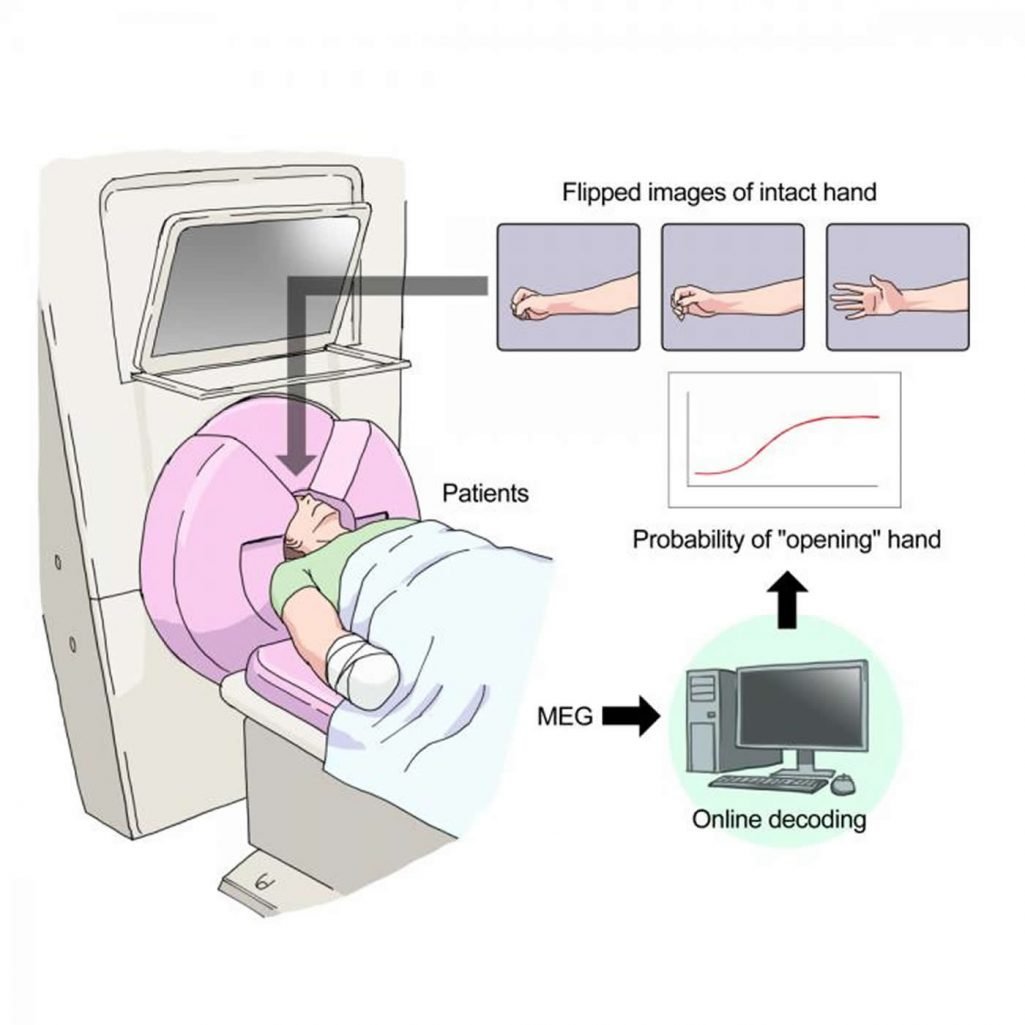Summary: Three days of training with brain-computer interface technology reduced phantom limb pain. Patients reported a 30% reduction in pain after one session, and the effect lasted up to five days after training was complete.
Source: Osaka University
Phantom-limb pain is as mysterious as the name implies. The vast majority of amputees experience “phantom-limb” sensations that make them feel their missing limb is still part of their body. The cause is still unknown, and 50% to 80% of the cases, the sensations are painful. With no established treatments or medication, phantom-limb pain can have a large impact on the quality of life and recovery for amputees.
Although the cause is unknown, one theory is that it happens when areas of the brain that used to control the amputated limb remain strongly connected to the mental image of the limb. To weaken this connection, one idea is to train the brain regions that control the intact limb to also control the phantom limb. Takufumi Yanagisawa and his team at Osaka University hypothesized that the key to accomplishing this was to do it unconsciously.
“It is very difficult to intentionally activate the part of your brain that controls your right hand without actually thinking about moving that hand,” explains Yanagisawa. “Instead, we designed a system in which the patients did not even know they were using those parts of their brains.”
In order to train the brains of patients with phantom-hand pain, the group used a brain-computer-interface. First they recorded brain activity when patients opened and closed their intact hands and used the pattern of brain activity as a template. Then they continuously recorded brain activity related to the intact hands, but asked the patients to try to control a virtual hand with their phantom hand. For half the experiments, this training was real; the recorded brain activity was decoded based on the template and the image of the opening/closing virtual hand was adjusted accordingly. For the other half, the images of the virtual hand were randomly adjusted with no connection to brain activity. All patients thought they were actually controlling the virtual hand. Patients trained for about 30 min/day for 3 days, and after each session they rated the intensity of their phantom-limb pain.

The team found that pain was reduced by 30% even on the first day of training and the effect lasted up to five days after training was complete. Importantly, only patients who received real training reported less phantom pain. They also found that after training, the mental image of the phantom hand was weakened in the brain regions that once controlled the amputated hand.
“These findings are promising,” says Yanagisawa, “especially given that alternatives like mirror training require a month of training to have the same effect. However, in order for this treatment to become truly practical, the cost must be reduced.”
About this neuroscience research article
Source:
Osaka University
Media Contacts:
Saori Obayashi – Osaka University
Image Source:
The image is credited to Osaka University.
Original Research: Closed access
“BCI training to move a virtual hand reduces phantom limb pain: A randomized crossover trial”. by Takufumi Yanagisawa et al. Neurology
Abstract
BCI training to move a virtual hand reduces phantom limb pain: A randomized crossover trial
Objective
To determine whether training with a brain–computer interface (BCI) to control an image of a phantom hand, which moves based on cortical currents estimated from magnetoencephalographic signals, reduces phantom limb pain.
Methods
Twelve patients with chronic phantom limb pain of the upper limb due to amputation or brachial plexus root avulsion participated in a randomized single-blinded crossover trial. Patients were trained to move the virtual hand image controlled by the BCI with a real decoder, which was constructed to classify intact hand movements from motor cortical currents, by moving their phantom hands for 3 days (“real training”). Pain was evaluated using a visual analogue scale (VAS) before and after training, and at follow-up for an additional 16 days. As a control, patients engaged in the training with the same hand image controlled by randomly changing values (“random training”). The 2 trainings were randomly assigned to the patients. This trial is registered at UMIN-CTR (UMIN000013608).
Results
VAS at day 4 was significantly reduced from the baseline after real training (mean [SD], 45.3 [24.2]–30.9 [20.6], 1/100 mm; p = 0.009 < 0.025), but not after random training (p = 0.047 > 0.025). Compared to VAS at day 1, VAS at days 4 and 8 was significantly reduced by 32% and 36%, respectively, after real training and was significantly lower than VAS after random training (p < 0.01).
Conclusion
Three-day training to move the hand images controlled by BCI significantly reduced pain for 1 week.







